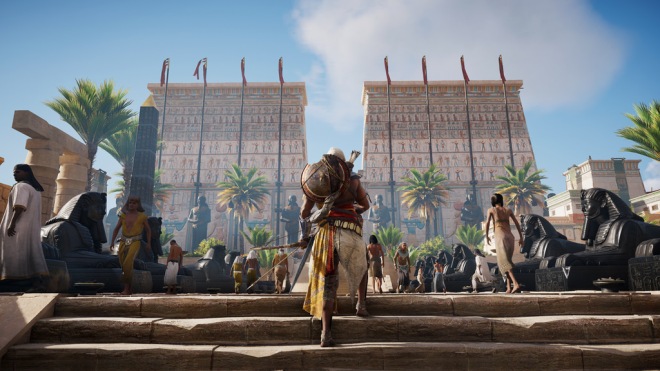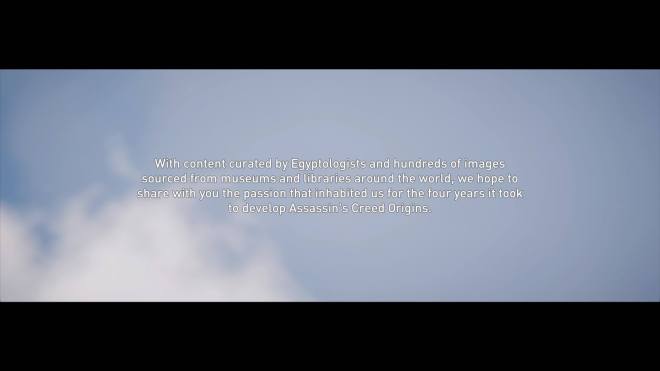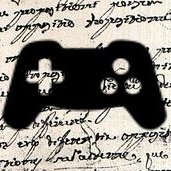The greatest strength of the Assassin’s Creed games has long been their detailed rendition of a historical world. The series’ open-world structure allows players to roam an intricate facsimile of past locations, whether those be 15th-century Florence, Revolutionary Paris, or, in the most recent entry, Assassin’s Creed: Origins, Egypt during the civil war between Cleopatra and her brother Ptolemy. While obviously not to scale, and designed to conform to the needs of gameplay as well as history, Origins’ digital Egypt garnered significant, and deserved, praise from both gamers and historians on the game’s release.

Origins’ digital Egypt is richly detailed, from details of hieroglyphics to the process of breadmaking. Where Origins and previous Creed games used these details as set dressing, Discovery Tour puts them front and centre.
While previous games came with an in-game encyclopaedia which would pop up to provide information about specific landmarks, characters, or social norms at certain points in the world, Origins lacks this feature. Instead, several months after release, Ubisoft released Discovery Tour: Ancient Egypt, a version of Origins with its combat, missions, enemies, and most other gameplay loops disabled[1]. Rather than Origins’ extended adventure, Discovery Tour is a digital exhibition. The mode is structured around 75 ‘tours’ within the game world, which prompt the player to move through a specific part of the environment and interact with ‘stations’ which provide voiced and text commentary, often with a relevant image – a digital version of a museum’s information board, as shown below:
These provide a tour through specific locations within the game explaining their historical counterparts, or on specific topics about life in Ptolemaic Egypt. Topics range from the construction of Alexandria and the fashion and beauty standards of Egyptians to the Roman army and its fortified camps and the development of Egyptology as a discipline. This wide range gives the mode a pleasing depth – whilst most tours are light on historiographical detail, going through the mode in full does provide a sense of the breadth of scholarship consulted in making Origins. Most can be completed in five to ten minutes; this, along with Discovery Tour’s reduced price-point, makes it accessible to greater audiences than the full game. The mode was explicitly designed by Ubisoft as a pedagogical tool[2], to help teach the history of Ancient Egypt and interest young people in history. In this, it’s a classic piece of Public History outreach, adapted to the tools of the videogame industry.
This contrasts strongly with the previous method of disseminating historical information in the Assassin’s Creed games. The in-game encyclopaedia that existed in previous games was integrated into the series’ framing narrative as an in-universe document, written to give the modern-day protagonist context for their digital exploration of the past. While it often included a great deal of factual information, it also mostly concerned itself with physical landmarks or broad-level political trends, and was delivered entirely in text form. Discovery Tour, in situating its tours in audio within the game world and encouraging the player to explore and observe NPCs[3] going about daily life, provides a greater context for the interpretation players are given. One of the most enjoyable activities in past Creed games has always been simply exploring its worlds and observing the crowd (with my personal high-point for this being Assassin’s Creed Unity and its exquisitely detailed Paris). Leveraging this strength for education purposes means Discovery Tour works on a level the encyclopaedia did not.

The most interesting parts of Discovery Tour, however, are the parts where tours provide detail into the process of constructing the game world itself. Sometimes these detail the technical challenges of creating the game, but some address the decisions around what to represent in the game and how. Origins and Discovery Tour are not 1:1 scale depictions of Egypt; that would be unfeasible at the level of fidelity the game aims for, and would negatively impact gameplay. Therefore, Ubisoft needed to make decisions about what to depict, at what scale and level of detail, as well as decide on interpretations as to what things looked like – always difficult when dealing with the ancient world. Discovery Tour’s occasional forays into uncovering this decision-making process are fascinating from a Public History perspective, for several reasons. First, they situate Discovery Tour itself within the historiography of Ancient Egypt, showing the game not simply as an entertainment product using the past as an aesthetic, but a self-aware depiction of the human past[4]. Second, they uncover why certain decisions were made, making it possible to discuss the game’s depiction of the past in terms beyond the simplistic dichotomy of accuracy and inaccuracy. While this is not a particularly common occurrence within Discovery Tour, exposing why decisions were made allows us to discuss the game’s depiction of the past in the context of the production of a video game, and the context of the game mechanics themselves.
This sort of thing is not new in the production of historical fiction: it is commonplace for an author to include a historical note at the back of a book, explaining where history differs from their depiction. ‘Making-of’ documentaries for film and television (and, indeed, for video games) expose the process of decision-making about fictional depictions of the past. Discovery Tour’s example is interesting, though, because Discovery Tour itself is not a piece of historical fiction (beyond the fictionalised nature of its world), but a piece of public history in its own right. Discovery Tour’s insights into production do not just shed light on the process of producing Origins, but the process and decisions that went into Discovery Tour’s own production. This is not necessarily an innovation, but it is somewhat uncommon in the context of educational and heritage products. The authority behind educational material is often invisible; interpretation is simply presented, without discussion of whose interpretation it is and the process of constructing it. While Discovery Tour does this as well, the glimpses of self-reflection and self-discussion are both unexpected and exciting.

The brief glimpses Discovery Tour provides into both Origins and Discovery Tour‘s production are fascinating and unusual.
More insight into the decisions going into Origins itself are an interesting possibility that Discovery Tour does not greatly leverage. Interactive reflection on the construction of a game is possible; notably, Valve’s Portal contains an interactive ‘developer’s commentary’ mode which dots interaction points similar to Discovery Tour’s stations via a playthrough of the game. This is a neat way to provide commentary on an interactive experience, and could be used to provide commentary (rather than simple historical information) on specific parts of the game world, aspects of the story, and on game mechanics. In a series that has previously generated controversy due to its depiction of the past (notably being criticised by a member of the French National Assembly for Unity’s depiction of the French Revolution), this could be a useful insight into the interpretation the game takes and the reasons for it. However, it is difficult to fault Discovery Tour for this: it is not, after all, a commentary on Origins.
What does all this mean for public history? If looked at simply as a game, then Discovery Tour is an interesting extension of an existing product. If looked at as a public history product, however, Discovery Tour hints at new and exciting possibilities. The series’ historical advisor has stated that “We want the Discovery Tour to be accessible for anyone”, but the mode does more than that: it widens the possibilities of participation in heritage more generally. Visiting Egypt is not an easy thing for most people to do due to geographical, political, and financial restrictions; neither is visiting many Egyptian artefacts not currently in Egypt. While heritage institutions are beginning to experiment with digital reconstruction and interactive exhibitions, these are generally restricted to on-site experiences.

Discovery Tour not only provides information about ancient Egypt, but also elaborates on the process of archaeology and research that provided its information.
At most museums or heritage sites, an online catalogue of artefacts or a Google Maps tour of the site is the best one can expect, meaning that those who can’t get to these places are effectively locked out of participation. Discovery Tour lowers that bar: whilst it requires specific hardware and an entry point, it is a detailed, carefully-crafted experience that the public can experience in their own home. Rather than being built to enhance a museum, it is built to stand on its own: not necessarily to replace the museum, but to serve those museums cannot.
In addition, the mode can reach places heritage institutions cannot. While museums and other institutions can offer outreach programmes to classrooms and educators, Discovery Tour can be used by teachers at any time, can be folded into a broader curriculum without requiring outside trips or organising visits. The interactive nature of the mode brings the past to life in a way that is especially crucial for young students – and the breadth of topics can help engage the entire classroom. Using historical fiction and documentaries are already a useful tool for teachers; in marrying the immersive qualities of video games and the informational rigour of the museum, Discovery Tour reveals a whole new world of pedagogical aid.

What Discovery Tour uncovers is the possibility of doing interactive public history at a scale much larger than most attempts, and that approaching the problem from the side of the games industry rather than the heritage industry has significant benefits: Discovery Tour would not be able to have its level of fidelity and detail had it been a project divorced from Assassin’s Creed. For the video game industry (and indeed for historical fiction more generally), it reveals the possibilities of detailed self-reflection and the way interpretation can be communicated. I hope that Ubisoft continues producing these modes, and that the upcoming Assassin’s Creed: Odyssey is followed by its own Discovery Tour.
[1] This was a free update for existing players and cost £15 if bought as a standalone
[2] Discovery Tour is described in Ubisoft’s statements as “a way to make the game more accessible to teachers and students”.
[3] Non-Player Characters
[4] More on this topic in future posts




You might enjoy http://www.digitalspy.com/gaming/news/a206596/gamings-forgotten-war-world-war-i/
J
LikeLike
That is indeed interesting! Since then, there have been a few major WWI games, including a major smash-hit in Battlefield 1, which I’ll be mentioning in the next post. Even so, it’s definitely a conflict that’s been less portrayed by gaming, and it’s interesting to think about why.
LikeLike
The Discovery Tour is the kind of thing I would have loved to have in my classroom. It would have engaged the History refuseniks, especially the KS3 boys, who were more interested in the latest Call of Duty; and those who found learning from texts difficult. It would also have helped those with SN engage with lessons.
The Discovery tour could be used to scaffold a lesson in engaging those at the lower ability end, and using it as a jump off point for further research for those at the higher ability end.
There must be a ready made market to tap into out there for developers in terms of Primary and KS3 History.
LikeLike
Hi. very interesting read indeed – I learnt something! However, if the game is designed to explore the origins and take you on a discovery tour – why so violent! I feel this could be a great platform for teachers to use in their classrooms but as I mentioned without the violence. I am 50+ year old so maybe I am missing something! Great read anyway, thank you Joel.
LikeLike
Hi Andrew! To answer your question, Discovery Tour is a separate mode within Origins, and is available as a separate product on PC. Within Discovery Tour, combat and combat AI are turned off, so the player cannot attack enemies, and enemies and wildlife will not attack the player. Thus there is no violence within Discovery Tour (other than mentioned violence when discussing relevant historical topics – educating about execution methods, for example, will always involve discussions of violence, but the mode does a good job of being appropriate for a general audience).
LikeLike
The discovery tour type format, when linked to a gaming experience that is fun and immersive, really offers great opportunities for learning and exploring history, even if it is not the intent of the player to undertake that journey. What, however, is the danger of reaching a mass audience with a skewed or even wholly inaccurate version of history, or worse with a deliberately manipulative version ? Who does the QC and what processes can be used for calling out those who abuse the past ?
LikeLike
This is a perennial problem for public historians, across all parts of the sector: how do we deal with misrepresentation, while keeping the public aware and acknowledging that history is fundamentally an interpretive discipline?
Usually, projects of this kind have historians involved, and Discovery Tour certainly did consult many historians, archaeologists, and Egyptologists to create the mode. Further, the mode’s use of copyrighted images (such as photographs of artifacts belonging to specific museums) is likely to have been contingent on the copyright-holder (the museum) being permitted input on the content to which the copyrighted image is appended; the QC, in effect, is being done by the historians creating the mode.
The process for ‘calling out’ bad history, though, is more nebulous and difficult. Again, if you lock two historians in a room and suggest a topic you’ll likely get five different perspectives on that topic, and what can seem like obvious misrepresentations can in fact be valid interpretations of evidence. With that being said, public historians generally regard it as part of our responsibility to push back against misrepresentations of the past, and academic historians in general are not at all shy about making a fuss over poor depictions of their specialised areas.
LikeLike